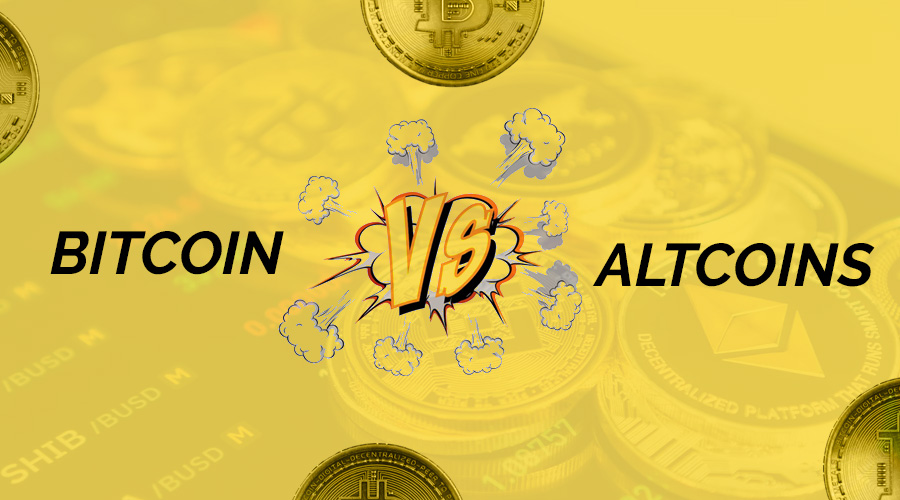 Contrasting Bitcoins & altcoins! Key crypto differences demystified. Insights here
Contrasting Bitcoins & altcoins! Key crypto differences demystified. Insights here
In the dynamic realm of cryptocurrencies, two prominent players have emerged: Bitcoins and Altcoins. While both share the core principle of blockchain technology, they diverge significantly in various aspects. This article delves into the key differences between Bitcoins, the pioneer digital currency that initiated the crypto revolution, and Altcoins, a vast category encompassing all other cryptocurrencies besides Bitcoin.
Exploring fundamental contrasts in technology, purpose, market share, and adoption, we aim to provide readers with a comprehensive understanding of how these digital assets vary and how they contribute to the ever-evolving landscape of decentralized finance. Join us on this illuminating journey into the fascinating world of Bitcoins and Altcoins.
What is Bitcoin?
Definition and Origins
Bitcoin (BTC) is the world’s first and most well-known cryptocurrency. It was invented in 2008 by an anonymous person or group of people using the pseudonym Satoshi Nakamoto and released as open-source software in 2009. Bitcoins are decentralized digital currencies that operate without a central authority or intermediary.
Blockchain Technology
The foundation of Bitcoin lies in its revolutionary blockchain technology. Blockchain is a distributed ledger that records all transactions made with Bitcoin across a network of computers. This decentralization and transparency ensure security and prevent double-spending, making Bitcoin a trustworthy and reliable digital currency.
Limited Supply
One of the defining features of Bitcoin is its limited supply. The total number of Bitcoins that will ever exist is capped at 21 million. This scarcity is built into the protocol, and it’s designed to mimic the scarcity of precious metals like gold, making Bitcoin a deflationary asset.
Dominance in the Market
Bitcoin’s dominance in the cryptocurrency market is unparalleled. As the pioneer of cryptocurrencies, it holds the lion’s share of the market capitalization, often serving as the bellwether for the entire crypto space.
What are Altcoins?
Definition and Purpose
Altcoins, short for alternative coins, refer to any cryptocurrency other than Bitcoin. They were introduced as alternatives to Bitcoin, aiming to address specific limitations or offer unique features. Altcoins come in various forms, each serving a distinct purpose within the digital currency ecosystem.
Diverse Range of Altcoins
Altcoins are vast and diverse, encompassing thousands of digital currencies. Some prominent examples include Ethereum (ETH), Ripple (XRP), Litecoin (LTC), and many others. Each Altcoin has unique selling points and use cases, catering to different niches and industries.
Different Consensus Mechanisms
While Bitcoin relies on the Proof-of-Work (PoW) consensus mechanism to validate transactions and add blocks to the blockchain, Altcoins have experimented with various consensus models. Some altcoins use Proof-of-Stake (PoS), Delegated Proof-of-Stake (DPoS), or other consensus algorithms, each offering efficiency, scalability, and energy consumption advantages.
Smart Contracts and Decentralized Applications (DApps)
One of the significant contributions of Altcoins is the introduction of smart contracts and decentralized applications. Ethereum, in particular, is a leading platform for building DApps and executing programmable smart contracts. These applications enable various use cases, from decentralized finance (DeFi) to non-fungible tokens (NFTs).
A Comparative Analysis
Now that we have explored the fundamental characteristics of Bitcoins and Altcoins let’s conduct a comparative analysis to highlight their key differences:
1. Purpose and Use Cases
Bitcoin primarily aims to serve as a digital store of value and a medium of exchange. Its primary use case lies in facilitating peer-to-peer transactions and serving as a hedge against traditional fiat currencies.
On the other hand, Altcoins often have more specialized use cases. For example, Ethereum’s ecosystem revolves around decentralized applications, enabling developers to create tokens and build complex smart contracts.
2. Technology and Infrastructure
While secure and reliable, Bitcoin’s blockchain has scalability and transaction speed limitations. Altcoins have taken on the challenge of addressing these issues by implementing various consensus mechanisms and technological advancements.
3. Market Volatility
As the first and most recognized cryptocurrency, Bitcoin’s market price is subject to extreme fluctuations. However, its status as a digital gold and a safe-haven asset has contributed to its resilience over the years.
Altcoins, especially smaller ones, tend to experience more significant price swings due to lower market capitalization and higher susceptibility to market sentiment.




